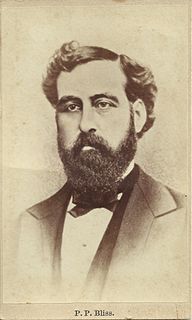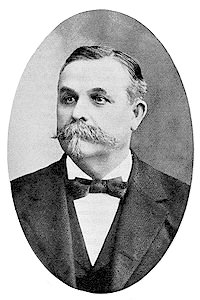Characteristics
Typically the original Gospel Song was composed using a dotted notes in an even measure, creating a swing rhythm. Harmonically often just the three main functions of a major scale were used. Melodically the Gospel Song restrained itself to triads, pentatonic scales and occasionally chromatic scales. Its verses are generated by repetition, sequences and inversion of just a few motives. Most of the songs feature a refrain.
The pursued aim of making the Gospel memorable and attractive as well is noticeable in the songs' lyrics, which for the most part state lots of emotion like the joy of salvation or restlessness of a sinful life – always accompanied by an invitation to find peace by submitting your life to Jesus. Addressed to already born again listeners the songs call to participate in God's work with the church and challenge to mission the unbelievers in your personal environment in order to grow and be productive in your faith. Poetic details are not often to find as well as complex theological correlations.
Undeniably being to a huge extent responsible for the overwhelming success of the Great Awakening the new songs were published in songbooks to use during Sunday service. In 1874 Philip Bliss published his fifth songbook entitled Gospel Songs. This new expression became common use to describe the new genre.
Today the old Gospel songs are sung all across the world, still mainly in Protestant and evangelical churches.

A hymn is a type of song, usually religious, specifically written for the purpose of adoration or prayer, and typically addressed to a deity or deities, or to a prominent figure or personification. The word hymn derives from Greek ὕμνος (hymnos), which means "a song of praise". A writer of hymns is known as a hymnist. The singing or composition of hymns is called hymnody. Collections of hymns are known as hymnals or hymn books. Hymns may or may not include instrumental accompaniment.

Contemporary Christian music is a genre of modern popular music which is lyrically focused on matters concerned with the Christian faith. It formed as those affected by the 1960s Jesus movement revival began to express themselves in a more contemporary style of music than the hymns, Gospel and Southern gospel music that was prevalent in the church at the time. Today, the term is typically used to refer to pop, rock, or praise & worship styles.
Gospel music is a genre of Christian music. The creation, performance, significance, and even the definition of gospel music varies according to culture and social context. Gospel music is composed and performed for many purposes, including aesthetic pleasure, religious or ceremonial purposes, and as an entertainment product for the marketplace. Gospel music usually has dominant vocals with Christian lyrics. Gospel music can be traced to the early 17th century, with roots in the black oral tradition. Hymns and sacred songs were often repeated in a call and response fashion. Most of the churches relied on hand clapping and foot stomping as rhythmic accompaniment. Most of the singing was done a cappella. The first published use of the term "gospel song" probably appeared in 1874. The original gospel songs were written and composed by authors such as George F. Root, Philip Bliss, Charles H. Gabriel, William Howard Doane, and Fanny Crosby. Gospel music publishing houses emerged. The advent of radio in the 1920s greatly increased the audience for gospel music. Following World War II, gospel music moved into major auditoriums, and gospel music concerts became quite elaborate.
Spirituals is a genre of songs originating in the United States and created by African Americans. Spirituals were originally an oral tradition that imparted Christian values while also describing the hardships of slavery. Although spirituals were originally unaccompanied monophonic songs, they developed into harmonized choral arrangements.

Shape notes are a musical notation designed to facilitate congregational and social singing. The notation, introduced in late 18th century England, became a popular teaching device in American singing schools. Shapes were added to the noteheads in written music to help singers find pitches within major and minor scales without the use of more complex information found in key signatures on the staff.

Ira David Sankey, was an American gospel singer and composer, known for his long association with Dwight L. Moody in a series of religious revival campaigns in America and Britain during the closing decades of the 19th century. Sankey was a pioneer in the introduction of a musical style that influenced church services and evangelical campaigns for generations, and the hymns that he wrote or popularized continued to be sung well into the 21st century.

Christian music is music that has been written to express either personal or a communal belief regarding Christian life and faith. Common themes of Christian music include praise, worship, penitence, and lament, and its forms vary widely across the world.
The colonial era in America began in 1607 with the colonization of Jamestown, Virginia. Music of all genres and origins emerged as the United States began to form. From the Indigenous spiritual music to the African Banjos, music in the United States is as diverse as its people. In New England, the music was very religious and was vitally important in the rising of American music. The migration of people southward lead to the settling of the Appalachian Mountains where many poor Europeans inhabited and brought country blues and fiddling. As music spread, the religious hymns were still just as popular. The first New England School, Shakers, and Quakers, which were all religion inspired music and dance groups, rose to fame. In 1776, St. Cecilia Music Society opened in South Carolina and lead to many more societies opening in the north. African Slaves came to the United States and introduced the music world to instruments like the xylophone, drums and banjo. The diverse music of the United States comes from the diverse type of people who first colonized this country.
Southern gospel music is a genre of Christian music. Its name comes from its origins in the Southeastern United States whose lyrics are written to express either personal or a communal faith regarding biblical teachings and Christian life, as well as to give a Christian alternative to mainstream secular music. Sometimes known as "quartet music" for its traditional "four men and a piano" set up, southern gospel has evolved over the years into a popular form of music across the United States and overseas, especially among baby boomers and those living in the Southern United States. Like other forms of music the creation, performance, significance, and even the definition of southern gospel varies according to culture and social context. It is composed and performed for many purposes, ranging from aesthetic pleasure, religious or ceremonial purposes, or as an entertainment product for the marketplace.

Church music is music written for performance in church, or any musical setting of ecclesiastical liturgy, or music set to words expressing propositions of a sacred nature, such as a hymn.
Kingdom songs are the hymns sung by Jehovah's Witnesses at their religious meetings. Since 1879, the Watch Tower Society has published hymnal lyrics; by the 1920s they had published hundreds of adapted and original songs, and by the 1930s they referred to these as "Kingdom songs" in reference to God's Kingdom.

Philip Paul Bliss was an American composer, conductor, writer of hymns and a bass-baritone Gospel singer. He wrote many well-known hymns, including "Almost Persuaded" (1871); "Hallelujah, What a Saviour!" (1875); "Let the Lower Lights Be Burning"; "Wonderful Words of Life" (1875); and the tune for Horatio Spafford's "It Is Well with My Soul" (1876).

Robert Lowry was an American preacher who became a popular writer of gospel music in the mid- to late-19th century. His best-known hymns include "Shall We Gather at the River", "Christ Arose!", "How Can I Keep from Singing?" and "Nothing But The Blood Of Jesus".
Traditional black gospel is music that is written to express either personal or a communal belief regarding African American Christian life, as well as to give a Christian alternative to mainstream secular music. It is a form of Christian music and a subgenre of gospel music.

James McGranahan was a nineteenth-century American musician and composer, most known for his various hymns. He was born 4 July 1840, in West Fallowfield or Adamsville, Pennsylvania, and died 9 July 1907 at his home in Kinsman, Ohio.

"The Sweet By-and-By" is a Christian hymn with lyrics by S. Fillmore Bennett and music by Joseph P. Webster. It is recognizable by its chorus:

Charles Davis Tillman —also known as Charlie D. Tillman, Charles Tillman, Charlie Tillman, and C. D. Tillman—was a popularizer of the gospel song. He had a knack for adopting material from eclectic sources and flowing it into the mix now known as southern gospel, becoming one of the formative influences on that genre.
"Good Shepherd" is a traditional song, best known as recorded by Jefferson Airplane on their 1969 album Volunteers. It was arranged and sung by the group's lead guitarist Jorma Kaukonen, who described their interpretation of it as psychedelic folk-rock.

George Coles Stebbins (1846–1945) was a gospel song writer. Stebbins was born February 26, 1846, in Orleans County, New York, where he spent the first 23 years of his life on a farm. In 1869 he moved to Chicago, Illinois, which marked the beginning of his musical career.








